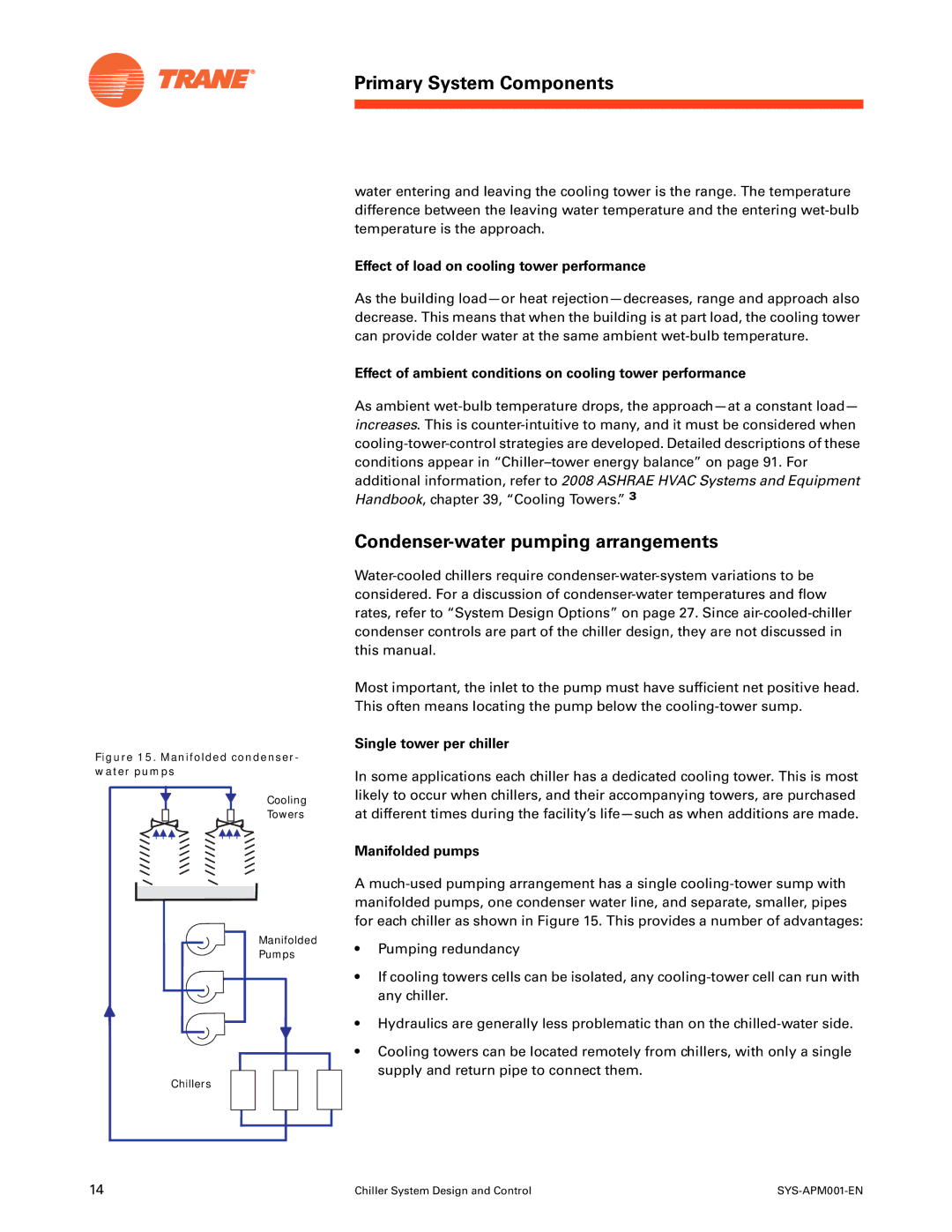May
Page
Chiller System Design and Control
Preface
Contents
100
Primary System Components
Chiller
Primary System Components
Chiller evaporator
Effect of chilled-water temperature
Effect of chilled-water flow rate and variation
Effect of condenser-water flow rate
Effect of condenser-water temperature
Water-cooled condenser
Maintenance
Air-cooled condenser
Air-cooled versus water-cooled condensers
Packaged or Split System?
Low-ambient operation
Energy efficiency
Loads
Air-cooled or water-cooled efficiency
Three-way valve load control
Two-way valve load control
Variable-speed pump load control
Face-and-bypass dampers
Chilled-Water Distribution System
Chilled-water pump
Manifolded pumps
Distribution piping
Pump per chiller
Pumping arrangements
Constant flow system
Condenser-Water System
Cooling tower
Primary-secondary system
Variable-primary system
Condenser-water pumping arrangements
Effect of load on cooling tower performance
Effect of ambient conditions on cooling tower performance
Single tower per chiller
Recommended chiller-monitoring points per Ashrae Standard
Unit-Level Controls
Chiller control
Centrifugal chiller capacity control
Centrifugal chiller with AFD
AFD on both chillers
Application Considerations
Small Chilled-Water Systems 1-2 chillers
Condensing method
Application Considerations Constant flow
Variable flow
Application Considerations
Number of chillers
Parallel or series
Part load system operation
Preferential vs. equalized loading and run-time
Mid-Sized Chilled-Water Systems Chillers
Managing control complexity
Large chilled-water system schematic
Large Chilled-Water Systems + Chillers, District Cooling
Water
Power
Pipe size
Chiller performance testing
Limitations of field performance testing
Chiller Plant System Performance
Controls
SYS-APM001-EN
SYS-APM001-EN
System Design Options
Guidance for Chilled- and Condenser-Water Flow Rates
System Design Options
Chilled-Water Temperatures
Standard rating temperatures
Standard rating flow conditions
Condenser-Water Temperatures
Chilled- and Condenser-Water Flow Rates
System Design Options Selecting flow rates
DP2/DP1 = Flow2/Flow11.85
Low-flow conditions for cooling tower Base Case Low Flow
Total system power Component Power kW Base Case Low Flow
System summary at full load
Coil response to decreased entering water temperature
Chilled water system performance at part load
Entering fluid temperature, F C
Cooling-tower options with low flow
Smaller tower
System design
ΔT2 = 99.1 78 = 21.1F or 37.3 25.6 = 11.7C
Same tower, smaller approach
Same tower, larger chiller
Same tower, smaller approach Present Smaller Approach
Retrofit opportunities
Retrofit capacity changes Larger Present Chiller Same tower
Cost Implications
Misconceptions about Low-Flow Rates
Misconception 1-Low flow is only good for long piping runs
KWh
SYS-APM001-EN
System Configurations
Parallel Chillers
System Configurations
Parallel chillers with separate, dedicated chiller pumps
Series Chillers
Series chillers
Primary-Secondary Decoupled Systems
Hydraulic decoupling
Check valves
System Configurations Production
Production loop
System Configurations Distribution
Distribution-loop benefits of decoupled system arrangement
Tertiary or distributed
Common
Campus
Decoupled system-principle of operation
Tertiary pumping arrangement
Flow-sensing
Temperature-sensing
Flow-based control
Subtracting a chiller
Multiple chilled-water plants on a distribution loop
Adding a chiller
Pump control in a double-ended decoupled system
Double-ended decoupled system
Chiller sequencing in a double-ended decoupled system
Variable-Primary-Flow Systems
Other plant designs
Advantages of variable primary flow
Operational savings of VPF designs
Chiller selection requirements
Dispelling a common misconception
Flow, ft.water Flow rate
Managing transient water flows
Flow-rate changes that result from isolation-valve operation
System Configurations
System design and control requirements
Effect of dissimilar evaporator pressure drops
Accurate flow measurement
Chiller sequencing in VPF systems
Bypass flow control
Adding a chiller in a VPF system
Flow-rate-fluctuation examples
Subtracting a chiller in a VPF system
Sequencing based on load
Other VPF control considerations
Select slow-acting valves to control the airside coils
Plant configuration
Consider a series arrangement for small VPF applications
Guidelines for a successful VPF system
Chiller selection
Plant configuration
Bypass flow
Chiller sequencing
Airside control
Heat Recovery
Chilled-Water System Variations
Condenser Free Cooling or Water Economizer
Plate-and-frame heat exchanger
Chilled-Water System Variations
Refrigerant migration
Refrigerant migration chiller in free-cooling mode
Well, river, or lake water
Preferential Loading
Preferential loading parallel arrangement
Preferential loading sidestream arrangement
Sidestream plate-and-frame heat exchanger
Sidestream with alternative fuels or absorption
Chilled-Water System Variations
Preferential loading series arrangement
Sidestream system control
Series-Counterflow Application
Series-series counterflow
Condensers
Unequal Chiller Sizing
Evaporators
Amount of Fluid in the Loop
System Issues and Challenges
Low ΔT Syndrome
System Issues and Challenges
Chiller response to changing conditions
System response to changing conditions
Example
Type and size of chiller
Contingency
Minimum capacity required
System Issues and Challenges Location of equipment
Alternative Energy Sources
Water and electrical connections
Ancillary equipment
Thermal storage
Plant Expansion
Alternative fuel
Flow rate out of range
Retrofit Opportunities
Applications Outside the Chiller’s Range
System Issues and Challenges Temperatures out of range
Precise temperature control
Precise temperature control, multiple chillers
Chilled water reset-raising and lowering
System Controls
Chilled-Water System Control
Chilled-water pump control
Number of chillers to operate
Critical valve reset pump pressure optimization
System Controls
Condenser-Water System Control
Minimum refrigerant pressure differential
VFDs and centrifugal chillers performance at 90% load
Chillers Difference
Condenser-water temperature control
Cooling-tower-fan control
Chiller-tower energy balance
Chiller-tower energy consumption
System Controls Variable condenser water flow
Chiller-tower-pump balance
Decoupled condenser-water system
Effect of chiller load on water pumps and cooling tower fans
CDWP-2
Failure Recovery
Failure recovery
Conclusion
Glossary
Glossary
Pumps system
Glossary
References
Plant. Idea 88th Annual Conference Proceedings 1997
References
Engineering July
102
Index
Ashrae
Index
105
106
Page
Trane

